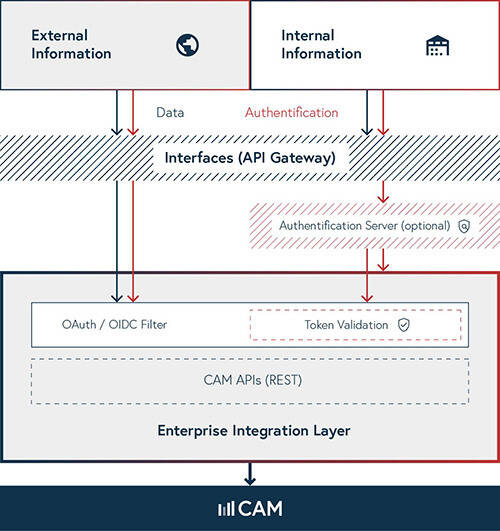Risk and credit management checks serve an overarching business purpose. Therefore, an essential prerequisite for the use of CAM in the heterogeneous corporate environments is the connection with various internal data sources and thus into the company's internal processes and systems. This multitude of different data streams must be organized well and efficiently. With the Enterprise Integration Layer (EIL), CAM provides the central hub for incoming and outgoing data streams (interfaces) - regardless of the type and source of the data or information.

Efficient Data Exchange with CAM
What Does the Enterprise Integration Layer Offer?
Standardized solutions are provided via corresponding interfaces (APIs) that enable bilateral data exchange with a wide variety of data sources and IT systems. The standardized, extensible interfaces allow, for example, many of the information providers (credit agencies) available in CAM to be addressed specifically via just one uniform API. Other examples of APIs are the data exchange of master or document data, external searches on the databases of connected information providers or the comparison with blacklists. For these APIs, the EIL provides a way to quickly and easily ensure the flow of data. For this purpose, the Enterprise Integration Layer has to be integrated once into the system landscape, whereby of course only those functions have to be connected that are important for the own company. The standard APIs offer a comprehensive range of functions to optimally map the usual use cases in CAM.
Modern technologies for the integration of data and services are used to make the Enterprise Integration Layer available to you in a future-oriented and maintenance-friendly way. For the Enterprise Integration Layer we use REST APIs (Representational State Transfer), OAuth 2.0 (OAuth) for authorization and OpenID Connect for authentication, so that you can connect your existing OAuth standard supporting systems like Keycloak, Okta etc.. The specification of the interfaces is done according to OpenAPI standard and is part of the delivery of CAM. Together, this enables integration into modern IT system landscapes.
Your Benefits
- Uniform, easy-to-connect, standardized interfaces
- For e.g. the connection of master and document data via REST interfaces or other data from your system landscape
- Integration of a wide range of international information providers via a uniform interface
- Easy extensibility and reuse of of existing interfaces
- Structured preparation of data

CAM Does the Heavy Work for You
You do not need any special requirements to use the Enterprise Integration Layer. For customers who do not have their own authentication server (Authserver) for OAuth and OpenID Connect, the Enterprise Integration Layer provides a lightweight partial implementation of the OAuth 2.0 protocol. This Authentication Server, shipped with CAM, is designed exclusively for CAM interfaces and optimized accordingly. The interaction of authentication and data retrieval is clearly illustrated in the following simplified diagram.
Available Features
- Authentication and Authorization
- Internal search
- External search via connected data providers (e.g. credit agencies and trade credit insurers)
- Creation, update, retrieval of address/master data
- Query overall rating and limit information
- Deletion of files
- Creation, update and retrieval of document data
- Availability check, ordering and retrieval of credit agency information
- Retrieval of information Name Screening / KYC
- Notification (PUSH messages in case of changed data)
We are continuously expanding the portfolio of APIs in the Enterprise Integration Layer.
Examples of the Use of the System Integration
Address Data Cleansing and Monitoring
Uncleaned address data is transferred from your existing Enterprise Resource Planning (ERP) system to CAM via API. In CAM, the process for enriching and cleansing master data is activated. The transmitted address data is checked in CAM, cleansed and extended by e.g. IDs of external service providers (e.g. DUNS or VC). After the cleansing is completed, a notification is sent to the ERP via the EIL. Cleaned data is now retrieved and transferred from the ERP system.
In this way, the address database of your own company can not only be cleansed once, but can also be kept up to date in all relevant systems.
Generation and Updating of Limits
Address data and document data are transferred from the ERP to CAM via API. CAM enriches this internal data e.g. with further external data such as credit agencies and trade credit insurances and determines the valid credit limit for a customer from this. Once the limit has been determined and updated, notification is sent to the ERP via the EIL. The updated limit (and, if applicable, further information such as rating) can now be retrieved and transferred by the ERP. The CAM system also uses all updated external and internal information that it automatically receives or retrieves.
This allows limits to be assigned and kept up to date according to the current known data - seamlessly and completely automatically without user intervention.
Your Industry, Our Solution


